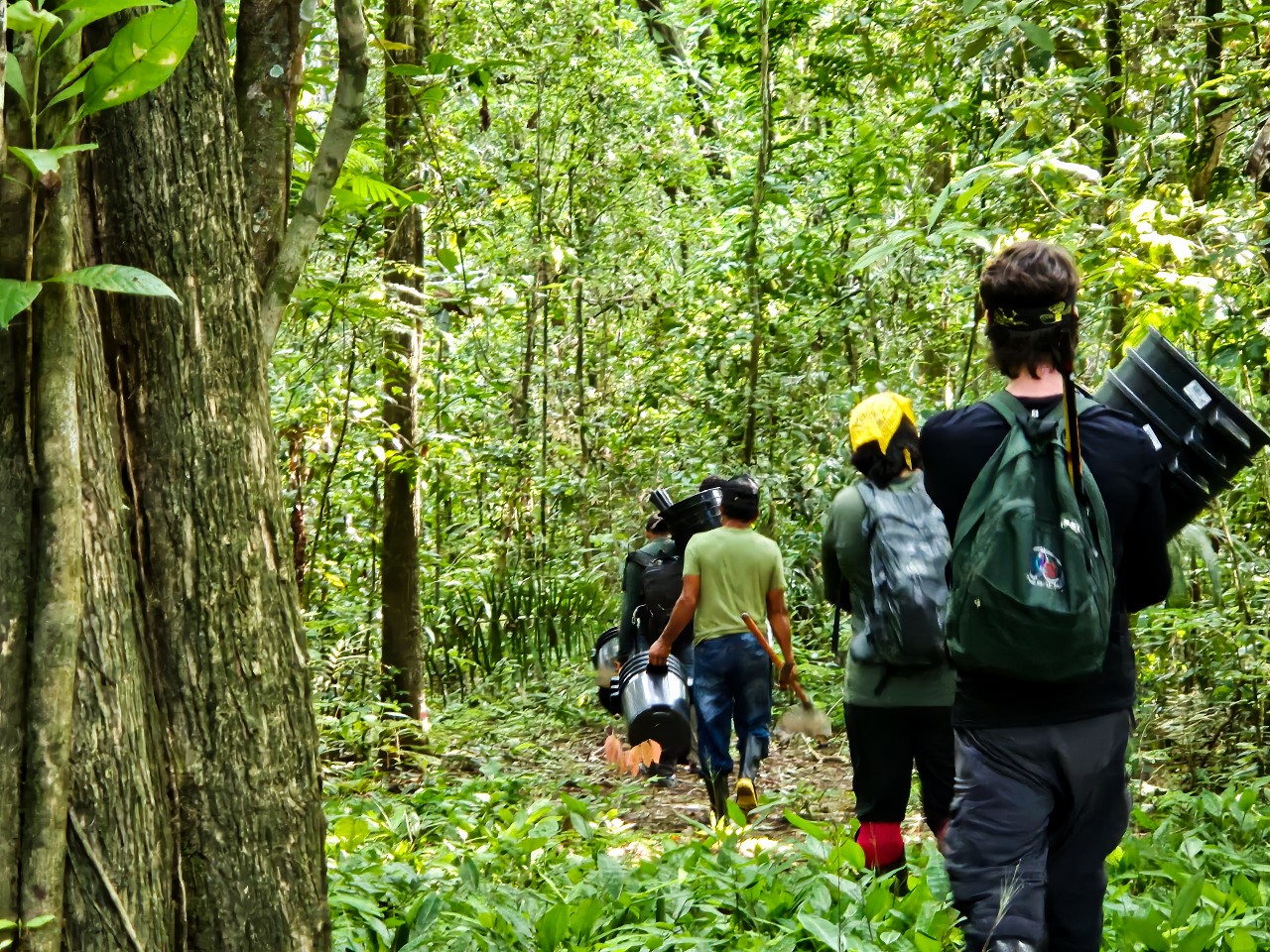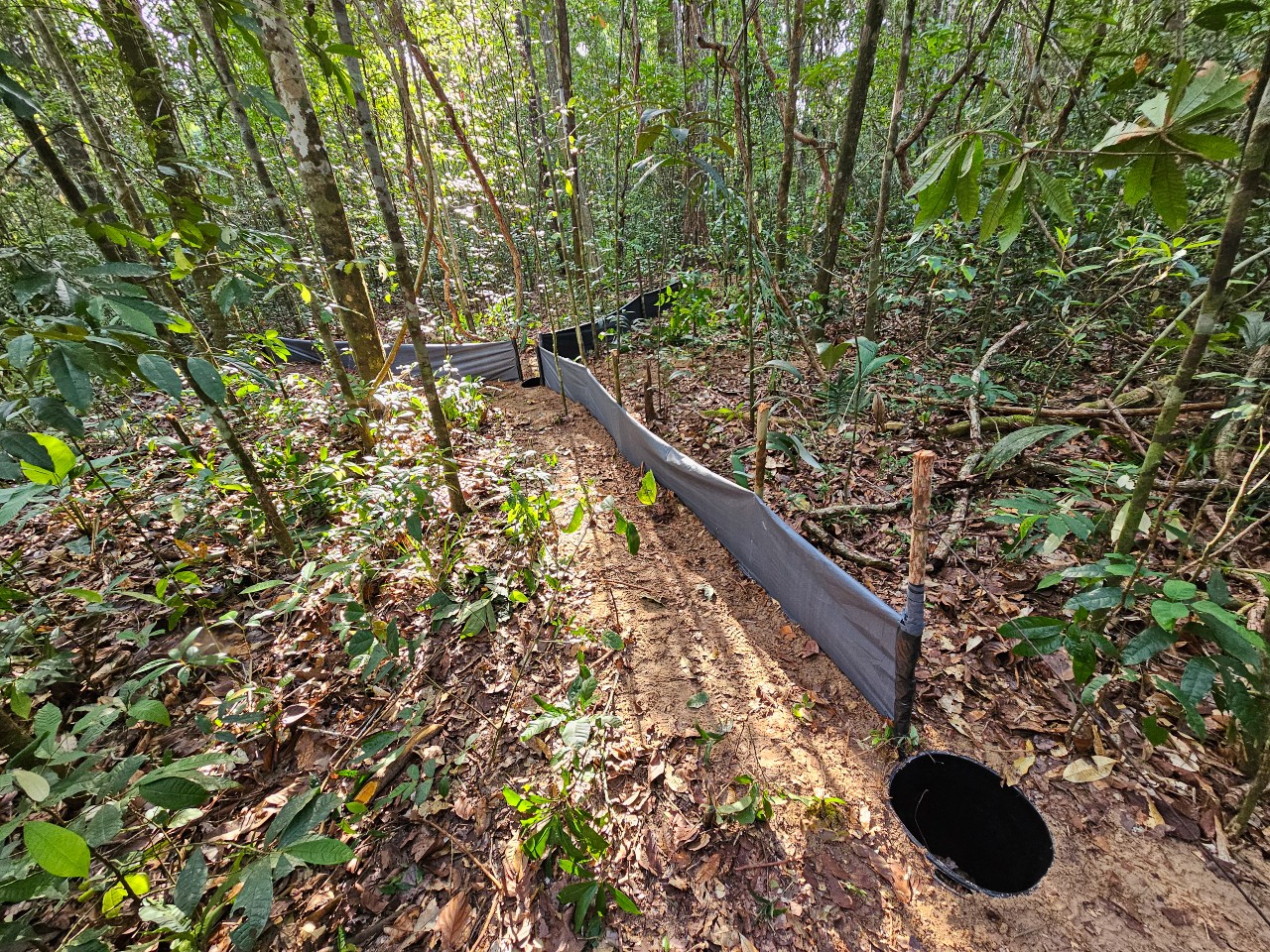

To collect the animals, the team set up traps at 20 points on Maracá Island, in Roraima (photo: Jordana Ferreira/INPA)
An expedition to the Maracá Ecological Station, about 130 kilometers from the capital Boa Vista, collected more than 400 specimens to study how these animals are coping with the temperature increases predicted for the coming decades. The work is part of the Amazon+10 Initiative.
An expedition to the Maracá Ecological Station, about 130 kilometers from the capital Boa Vista, collected more than 400 specimens to study how these animals are coping with the temperature increases predicted for the coming decades. The work is part of the Amazon+10 Initiative.

To collect the animals, the team set up traps at 20 points on Maracá Island, in Roraima (photo: Jordana Ferreira/INPA)
By André Julião | Agência FAPESP – A team of researchers spent 28 days on Brazil’s third largest river island, the Maracá Ecological Station (ESEC), in the state of Roraima. In the federal conservation unit, about 130 kilometers from Boa Vista, the state capital, the expedition members collected about 400 specimens of reptiles and amphibians, as well as morphological and ecological data to assess the animals’ physiological responses to rising temperatures.
“Our project focuses on the impact of climate change on amphibians and reptiles, with the aim of improving predictive models of extinction risk and species’ potential to adapt to environmental change, for example. To do this, we’ve developed a series of field and laboratory experiments and analyzed a large amount of data. But it all starts with sampling individuals in the wild and collecting the associated information,” explains Fernanda Werneck, a researcher at the National Institute for Amazonian Research (INPA) who is coordinating the studies.
The expedition is part of the project “Climate Change and Amazonian Socio-Biodiversity: Perspectives on Herpetofauna”, supported by the Amazon+10 Initiative.
In addition to FAPESP, it is supported by four other State Research Foundations (FAPs): FAPEAM, from the state of Amazonas; Fundação Araucária, from Paraná; FAPESQ, from Paraíba; and FAPT, from Tocantins. The expedition also received funding from the National Council for Scientific and Technological Development (CNPq), affiliated with the Ministry of Science, Technology and Innovation.
Werneck recalls that the project has conducted other expeditions in other regions of the Amazon. But this one, the first at the Maracá ESEC, was more logistically challenging.
The island is home to the region’s characteristic environments, such as the lavrados, open formations within the Amazon rainforest, in addition to the terra firme forest physiognomies. Despite being an integral conservation unit, where visitors are only allowed for scientific studies, the surroundings of the Maracá ESEC suffer from illegal hunting and fishing, as well as mining. The site is home to a base of the Chico Mendes Institute for Biodiversity Conservation (ICMBio), linked to the Ministry of the Environment and Climate Change, which manages and supervises the area and supported all stages of the scientific expedition.

Aerial photo of the scientific and support base of the Maracá Ecological Station. The surroundings include forested areas and natural open spaces (photo: Romério Briglia/ICMBio/NGI Roraima)
In May 2021, criminals invaded the base, held brigadiers hostage, and took equipment that had been seized weeks earlier from wildcat miners working in the area.
The Ecological Station is one of the last stops before entering the Yanomami Indigenous Land, a historic target of wildcat mining in the Amazon. This was the first visit by researchers to the Ecological Station since the invasion in 2021, and they were escorted by the National Public Security Force.
“Despite the previous context of tension in the region, at no time did we feel threatened and the work proceeded as planned,” says Felipe Augusto Zanusso Souza, an INPA researcher who coordinated the planning, logistics and execution of the expedition.
Along with six other team members, Souza spent 28 days in the field. Most of the group, about 50 researchers and support staff, took turns working two-week shifts.
Routine
After setting traps at 20 points around the island, the team visited the sites daily to collect the animals they had caught. Active day and night searches were also carried out, looking for reptiles and amphibians on the ground and in the vegetation, as in the case of arboreal species. The specimens were then taken back to the base, where they underwent a series of tests in the field laboratory set up during the expedition.

Catch and drop traps. The passive collection method consists of interlinking four buckets with “Y” shaped tarpaulins and checking them daily to collect amphibians and reptiles (photo: Jordana Ferreira/INPA)
Post-doctoral researchers, technical support and knowledge dissemination fellows, and master’s and doctoral students from the participating institutions worked together to collect material and conduct the experiments, which will lead to joint work and parts of their theses and dissertations.
This was the case of Juliana Luzete Monteiro, who is doing her Ph.D. at the Ribeirão Preto School of Philosophy, Science and Letters of the University of São Paulo (FFCLRP-USP) with a scholarship from FAPESP. Her goal is to study the evolution of sexual development in lizards of the genus Hemidactylus.
“I collected a species native to the Amazon to analyze whether there are differences in locomotor performance between males and females. In this experiment, the animal runs on a track with vertical and horizontal inclines and we film everything. We then assess whether there are differences and whether they could be related to morphological distinctions between the sexes, such as the size of the legs or digits, for example,” says Monteiro, who also collected tissue from the animals to analyze sex chromosomes.
Her work was supervised by Tiana Kohlsdorf, a professor at the FFCLRP-USP, supported by FAPESP.
Among the various experiments conducted, the researchers tested the preferred temperatures, locomotor performance, and thermal tolerance of reptiles and amphibians from the area.
In one of them, the animals were placed in a box with eight runway-like subdivisions. The structure was subjected to a gradient of cold to hot temperatures, between about 20 °C and 40 °C. Their body response was then recorded every minute for an hour. The average found is the so-called preferred temperature in the laboratory, which gives a parameter of what would be ideal for each species.

Critical temperature experiment where the specimen is heated or cooled in the thermal chamber (left) and then its body temperature is measured (photo: David Ayronn/Rede BIOTA Cerrado)
In another experiment, after resting from the previous one, the animals were subjected to temperatures ranging from 5 °C below ambient to 5 °C above ambient and then stimulated to run on a track, with each run recorded for later determination of speed.

Locomotor performance experiments, called “running.” They can be either vertical (left) or horizontal, depending on the type of habit of the species being tested. The runs are recorded and the footage is then analyzed (photo: Jordana Ferreira/INPA)
Finally, the individuals were subjected to decreases and increases in temperature and placed on their stomachs. The minimum and maximum critical points (or their thermal tolerance) were determined from the temperature at which they stopped trying to turn around to correct their body position.
New expeditions will repeat the procedures in other regions of the Amazon. In the laboratories of the institutions, genetic data and the expression of proteins linked to thermal shock, among other factors, will be analyzed. The information will support papers to be published in the coming years.
The collected animals will be deposited in the INPA Amphibian and Reptile Collection (INPA-H), where they will be available to other researchers for further studies. The project also includes the monitoring of Amazonian turtles in the Araguaia-Tocantins and Negro river basins.
On the socio-environmental side, researcher Matheus Ganiko Dutra, of the FFCLRP-USP, is conducting a discourse analysis of riverside populations on the relationship between the environment and climate.
Mitigation
According to the United Nations’ Intergovernmental Panel on Climate Change (IPCC) 2023 report, the average global temperature increase by 2050 could be between 3.5 °C and 5.7 °C, depending on greenhouse gas emissions over the next two decades.
“It’s essential to understand now what could happen to these species in a global warming scenario so that we can take mitigation measures in time and subsidize biodiversity conservation strategies based on robust biological data,” concludes Werneck.
The team included professors, researchers, post-doctoral fellows, and master’s and doctoral students from the five institutions participating in the project within the Amazon+10 Initiative: the Federal Universities of Pará (UFPA), Paraná (UFPR) and Tocantins (UFT), in addition to USP and INPA.
Other partners include researchers from the Federal University of Amazonas (UFAM) and the University of Brasília (UnB). The expedition was only possible thanks to a large support team, ranging from field assistants to cooks.
Republish
The Agency FAPESP licenses news via Creative Commons (CC-BY-NC-ND) so that they can be republished free of charge and in a simple way by other digital or printed vehicles. Agência FAPESP must be credited as the source of the content being republished and the name of the reporter (if any) must be attributed. Using the HMTL button below allows compliance with these rules, detailed in Digital Republishing Policy FAPESP.





